#michael ralph interview
Explore tagged Tumblr posts
Text
Michael Ralph, the Good Omens Production Designer, interview for Movieweb :), summer 2023
Question: What is your reaction to your fan's positivity?
Michael Ralph: It's unbelievable. To see your work reflected in the eyes of people that love it is incredibly complimentary and it feels on, you know, you're honoured by having that response .It's rare that you get to experience it. You know, I think that we were involved recently in a fans' view of the set where all the fans who'd been involved in a competition were able to walk around the set. It's extraordinary. And I got hugs and people in tears. And it is an overwhelming experience to stand in that street and be in that bookshop when you didn't think, even though you knew, but you didn't quite know it really existed as a place that you could walk around in is quite phenomenal.
Question: Do you see locations as extensions of characters?
Michael Ralph: My feeling is that we would all, if possible, choose to live where we believe and within an environment that we believe suits us, doesn't suit anyone else. It's a fingerprint thing. It's like, where are you most comfortable? Where are you most comfortable to read or to write or to watch a programme or where do you feel the most secure?That bookshop is an anchor point visually for the show and always has been an anchor point since day one. And it is where you feel most secure. It's where the door closed, you feel safe within it. And what emanates or resonates with that bookshop, not only from the character and the position or who Aziraphale is, is that everybody that walks into that bookshop feels the same thing. Everyone that walks in that bookshop, I've said it before, just want to live upstairs and drink red wine and read books all day and they feel comfortable and they feel nostalgic and it creates a sense of security and protection. And I think that if you can create that sort of sentimentality in something that you're walking around in, it must transcend the lens. And it obviously does because people feel it all the time and they want to go there and sit around in the corner and feel comfortable. So I think that from character point of view, I started really emotionally from Aziraphale. And Neil, whenever I've thought of a great idea that I tell Neil about and he tells me how amazing it might be or how fantastic or inspired it was, I suddenly start to realise it's probably in the book or it's probably in the script between the lines. What stimulates my apophenia, what stimulates my vision and my emotional motivation to design anything is what I can see in the page. So if he has written something so universally empathetic to an audience, then I'm seeing the same thing you are, in my variation, but it really is the same warp or the same sentimentality as I said, or any of those things. So if I can find how to get my fingernails under the edge of that, how I can actually depict it, then I know that it's going to work. And that's obviously... and you can believe in it then, and you can say it with all honesty, rather than impersonate your love for something or say something because your ego tells you you should, or produce something that's a duplicate of something you saw once in Italy. This is something you've got to feel that's specific to the project and specific to the written word, you know.
Question: Do you have the freedom to do what you want?
Michael Ralph: I must admit, reading the book the first time, it was difficult to get my head around how it was going to be depicted. You've got to be very careful that you don't impersonate what you've seen before, you don't copy and then call it original when it's not, because that's sort of like a cop out. You really, honestly have to live with it 24 hours a day, even while you're asleep, and search and search and search and search to find what it is that gets your fingernails under it, to find out what it is you really believe in. And it sounds so ethereal, but it's absolutely true. If you can get that, if you can openly find that, and you've got to feel that, if you can get that, then you're absolutely on something you can invest in and then something you can produce. Because then it's not something that's duplicated. All the furniture, literally all the furniture, all of the dressing on the walls, all of the bookshelves are all built but Bronwyn, a set decorator, will buy me a lot of brown furniture that she finds as really interesting furniture. Furniture that's got spindles and handcarved pieces and reliefs in it. And she gets me stuff that she believes goes with the character of the place. And then I'll break it open. This is what construction. I love working with construction with, because I'll break it open, cut it down, reattach it, and I'll remake wholewalls and bookshelves, like in the magic shop that none of it existed until we put together loads of stuff the set decorator found, that Bronwyn found. And then all that stuff ends up having a profile of the period, or echoes to you, little visual trip hazards of the period, of size and weight. But it isn't really anything you've ever seen before. It's not from a higher shop. It's not from a piece of furniture you bought, just plunk there. Because the camera sees things differently. And we have to lift all that up and make it bigger and larger in scale to punctuate the vision. So all of that is... there's all sorts of theories, I could go on forever, you know. I was saying to Bronwyn today that I think I've been working all my life on trying to raise my intellect, to be able to incorporate a vocabulary to explain what it is I do creatively. I'm not there yet.
Question: Is there something you'd like to explore in the future?
Michael Ralph: And it's funny you should say that, because that process, from what I've explained to you, doesn't originate with me. So you need to get that book or that source material, and someone has to say, you're the guide for this, I'd love to see what you see. And then it's like this massive submerge, you submerge into it. And then it's a journey, a journey that you embrace and it reveals things that I could guess maybe 15-20 things I'd like to do on Season Three, but it's not scripted. So what is that? You know, I've got imaginary things that I will adopt because I know that they've got weight or purpose that will work for Season Three. But I need to see what Neil shows me, you know, what Neil teaches and tells me, and then once I've seen that, I can run with it. He's such a wonderful appreciator of what you achieve. He's never questioned anything I've done, ever. And it's been hundreds of things, hundreds of sets and ideas. And no matter how crazy what it is, I might end up drawing the craziest things first. But he still loves them, you know. And it feels like it probably was there already between the lines. And all I've done is pick up on it. You got to really get into it to mime what it is that affects you and what moves you. What it is you love about something. You can watch a show and read a book and not love it. You don't know why you didn't love it, it's unequatable, but you just didn't connect. But what we're trying to do with everything we do cinematically is to connect, is to somehow get through the equation. So you feel it. And I got a feeling that's why Good Omens works so well. Because of the amount of love and emotion that people put into it and amount of faith people have in what they're doing, because it's only done out of joy and it's only done for the goodness of that wonderful story that is developed and matured, within it, between the characters. And because of that, you can do nothing but sprinkle magic on it all the time.
#good omens#gos2#season 2#interview#michael ralph#michael ralph interview#s2 interview#videos#video interview#transcripts#movieweb#bts#bronwyn franklin#aziraphale's bookshop#fun fact#neil gaiman
630 notes
·
View notes
Text
Crowley’s Mayfair flat design (concept art) for season 1 was inspired by an art installation in the Royal Academy of Arts called “Sensing Spaces”; in particular this piece from Grafton architects.


This installation “aimed to evoke the experience of contemporary architecture within a neoclassical environment”. Especially the light “coming in” from overhead was the most important aspect.


Most poignant of all was to recreate the light sensation of both moon and sun simultaneously.
The spatial qualities of light and shadow shaped the installation by Yvonne Farrell and Shelley McNamara of Irish firm Grafton Architects. The architects suspended large wooden structures from the ceilings of two galleries to recreate the experiences of both sun and moonlight.

The structures by Grafton Architects, founded by Shelley McNamara and Yvonne Farrell, hover above Gallery IX and the Lecture Room, suspended from the roof lights above. In order to create a strong spatial tension between adjacent rooms and to set up different lighting scenarios, two dramatically different compositions have been made. Choosing only to work with the roof lights, both installations feature a series of suspended surfaces and forms that manipulate the light and reshape the space in two entirely different ways; one as an exploration of lightness, with what is referred to as a waterfall of light, and the other being the exact opposite, exploring weight, containment and the formation of carved-out space. In the Lecture Room, a series of dark, brooding and apparently massive solid forms obscure most of the existing ceiling and roof light, articulated by two relatively small, high-level ‘apertures’ or openings of light. In contrast to this, Gallery IX features nine blades, suspended in alignment with the gallery’s exposed trusses to reflect a balance of natural and artificial light filtered through the exposed roof light. While both installations drop down within the galleries to create an implied headroom of 2.5 metres within the 8.5-metre-high spaces, two entirely different relationships are established between the floor and the light. In the Lecture Room, the installation intensifies the perception of distance between the floor and the light, while in Gallery IX the hanging blades bring proximity and unity. By quoting American architect Louis I. Kahn’s statement that ‘to hear a sound is to see a space’, Grafton Architects allude to a consistent ambition in their work to make space tangible. As they put it, they seek to ‘make as much nothing as possible’, and to structure space through the careful orchestration of the passage of light and movement through the void. In response to what they refer to as an ‘amazing generosity of space’ within the Main Galleries of the Royal Academy, their installations set out to radically transform each visitor’s perception of the familiar. As such, between Gallery IX and the Lecture Room the architects have created two distinctly different scenarios which, when experienced side-by-side, set up a powerful spatial duality and tension that reinforces the qualities of the existing rooms while radically transforming them into something new. (for a complete 360 view of the rooms)


‘As well as enabling us to find greater pleasure in the spaces we inhabit, this exhibition will perhaps heighten our awareness of the sensory realm of architecture and thereby encourage the creation of a more rewarding built environment.’


From Michael Ralph: Crowley’s flat was the first piece of concept art he did before booking the job, and it stayed the same. He sent in seven pieces of concept art before he went for an interview, and four of them stayed exactly as they were – nothing changed from his original instinct. The idea of the apartment was for it to be almost a cement tomb but with a very high ceiling (hanging in mid-air) so there was a sense of light coming in from a very high level.
And just a piece I want to highlight: "manipulate the light and reshape the space in two entirely different ways; one as an exploration of lightness, with what is referred to as a waterfall of light, and the other being the exact opposite, exploring weight, containment and the formation of carved-out space."


In a way, the flat has always possessed a bit of light and shadow, something reflected in Aziraphale and Crowley's own essences.
#good omens#ineffable husbands#crowley#aziraphale#behind the scenes#good omens crowley's flat#sensing spaces#it is all about touch#and light#and them coexisting#good omens fun facts#set design#concept art
121 notes
·
View notes
Text
Introduction
Current hyperfixation: Stranger Things
I'm just a silly little guy, I promise :)
About Me
I'm Dani, and I use they/them. I speak English and French, so feel free to talk to me in either! I use il in French :D
I'm aroace and nonbinary
I'm autistic, chronically ill and depressed, so if I come across as weird that's probably why XD
Fandoms
Final Fantasy IX, Final Fantasy XIII, Marauders, Blue Lock, Persona 3, Persona 4, Persona 5, How To Train Your Dragon, Rise of the Guardians, Alien Stage, Interview with the Vampire, All For The Game, Stranger Things, Code Vein, Lord of the Flies
Ships
I'm a multishipper, but my favourite ships are Jegulus, Rosekiller, Nagireo, Kaisagi, Kainess, Yukamitsu, Ryomina, Souyo, Shuake, Hiccstrid, Hijack, Loustat, Andreil, Byler, Zidagger
Favourite Characters
Lightning Farron, Hope Estheim, Regulus Black, Pandora Rosier, Bachira Meguru, Michael Kaiser, Alexis Ness, Yukari Takeba, Yosuke Hanamura, Goro Akechi, Hiccup Haddock, Astrid Hofferson, Jack Frost, Louis de Pointe du Lac, Andrew Minyard, Mike Wheeler, Will Byers, Mia Karnstein, Vivi Ornitier, Garnet til Alexandros, Zidane Tribal, Ralph
Special Interests
Reading, writing, playing video games, watching anime, baking, cats
The Familr
@rainystarssx: my quadruplet and blanket burrito buddy. I love her so much, she deserves the world <3
@mairon-goth-minion: my quadruplet, and a baguette
@equippedtolove: also my quadruplet :D
@blueberry0409: my sister
@hawaiianshirttaco64: my brother
@l1ve-l4ugh-lov3craft: my sibling-in-law and a ghost
@guess1mjustheren0w: my aunt
@the1970sdeadgaywizard-regulus: my uncle? I think?
@yesiamprocrastinating: my mom??? I don't remember being adopted by her though XD
@allonsy-moony: my great uncle? Maybe?
@percyweasleyapologist: GRANDMA :D
Honourable mention to @thatrandomlemononyourcounter1, who I am coparenting Hope Estheim with (he is our fictional son, but our son nonetheless <3)
My pronouns page:
36 notes
·
View notes
Text
S2E1 - The Arrival Write Up P2 - the Present Day up to the introduction of Maggie and Nina

Right, first thing I want to address straight off the bat (sort of – straight off the bat for a point where I have something I can use for comparison). I’ve always felt the colours in the second season are so much more vibrant than in the first. I’ve never been sure that it wasn’t just a case that the image quality was better – the placards are a great example of this, they’re so much crisper and finely detailed. But now I’m in full examination mode, I can look at the colour issue a little bit more.


I’ve tried, as best I could, to get two shots that are of the same location from each season – first on the left, second on the right. They’re not perfect comparisons, but without spending hours on this one little point, that’s all you’re getting. Maybe it’s the lighting, maybe it was the weather; whatever the reason the colours in the second season shots are definitely brighter, more vivid. I’d be interested to hear if other people felt the same way. Part of me wonders whether the use of brighter tones is directly related to the general mindset of our hero couple, seeing as they’re both very comfortable in their authority-free lives at the start of the second season.
Alright, next up – that one-shot that starts immediately after the end of the credits (which I absolutely love), going from a birds-eye view of London (from a long way up!), down into Whickber Street and then, oh so smoothly, through the letterbox to land us up in the bookshop. I’ve heard mention (thanks to @curiouspupsicle) that those aerial shots are potentially a sub-textual hint that God is watching over everything. That would be an interesting concept for this season, seeing as God as a narrator is missing, and that both Crowley and Aziraphale are supposed to be being left alone – I’ve always thought the lack of those omnipresent voiceovers in this season signifies that God has in fact turned a blind eye to whatever it is that the angel and demon are up to on Earth, but that aerial shot might suggest otherwise.
As with the nebula numbering in the opening scene, I was hoping for a little Easter egg somewhere on the invoice form that Maggie has written her note on, but alas, I couldn't find anything glaringly obvious in Strong’s concordance.

There are two things I want to talk about in this shot. The first is more of a wondering – do we think there’s some level of grim foreshadowing with the clear view of only one half of the coffee shop name directly behind Aziraphale’s shoulder? As with everything in this series, I think coincidence and chance are things that don’t really happen, and that everything is done with a purpose in mind, so I’m of a mind that this is deliberate. I’m just struggling to put the pieces together on that one, seeing as Aziraphale doesn’t choose death at the end of this season (or not in an obvious way at least). The other thing I want to bring up is much lighter – it’s the incredible job that the set dressers and prop creators have done for this shop. All those records! And the ones that are on obvious display have all been adorned with made up artist names. I don’t think I could possibly identify them all if I ever want to finish this set of write ups, but “Rat Keith” appears to have been a favourite, along with “C.T. Bazz” and “Gomez, y Gomez, y Ramirez”. There is a short article covering an interview with the production designer Michael Ralph that talks specifically about the creation of this part of the set that has a couple of nice insights. Bravo everybody involved with this one – it’s a bloody masterpiece.
A note on Aziraphale’s reaction to Maggie saying she’s going to leave the shop – isn’t it kind of adorable that, despite the fact that he’s been living amongst humans and immersing himself in their ways for 6 millennia, the only reason he can think of for a business owner having to vacate their business premises is because they don’t like the location? It says so much about the goodness of his character that his worst nightmare here is that Maggie no longer likes the space he provides for her. You have to give some credit to Maggie here though, because hers is one of the most realistic reactions we get to see with regards to the batshit craziness that is so often taken for granted in this show.

Oh. Ah. Wait I see. Goodness of character I said? What was I thinking? This guy just wants his records. And if that that lecherous glance at his soon-to-be property doesn’t tell you that, his next line will:
AZIRAPHALE: Maggie if you were out of here, where would I get my records?
Now, before I go upsetting any of you, I want you all to know that I love Aziraphale. And (spoiler alert) I don’t hate him for the Final 15. With that said… SELFISH MUCH? He’s such a funny little conundrum (and I do know that’s kind of the point of the vast majority of this show) – being of Heaven, and therefore being good and kind and charitable, yet being so blatantly selfish at the same time. It’s something we do see in his character at several points in this show, but this is perhaps the most overtly that it’s stated.

Alright, I have to talk about this. It was always something that I had written down in my notes, but as I was writing this, something else occurred to me that actually gave me a chill. Let’s start with the first part of this line:
AZIRAPHALE: I’m very good at forgiveness…
Now this is an interesting claim to make. We’ve seen him specifically apply a type of forgiveness twice up to this point – once during the argument in Soho, the other where he asks for Crowley to be forgiven during the band stand scene. Have we ever seen any evidence that he actually is good at forgiving somebody for their sins? He’s certainly not good at it when Crowley comes back to the bookshop later in this episode. Or with Michael, Uriel and Sandalphon for their attack on him in the street – in fact we see him bear an undeniable grudge in relation to their actions. Perhaps his claim is made under the same premise that he assumes he inherently possesses so many other “good” qualities – he is of Heaven, therefore he must have them. Let’s mull all of that over whilst we think about the next bit of the line:
AZIRAPHALE: …it’s one of my favourite things.
On the surface, this would seem to be a simple way of backing up his claim. And here’s where my blood ran a little bit cold. Is this… a Sound of Music reference? We’ve actually even seen this very reference used once before in season 1:
SANDALPHON: These are a few of our favourite things.
Now, let’s side aside my original (very pathetic) epiphany that any time we have a Sound if Music we should interpret that as a BAD OMEN for a moment. Let’s instead remind ourselves of Aziraphale’s reaction to being told that there’s someone in his immediate circle of connections that really loves Sound of Music:

Hmm. Seems he’s not a fan. So why would he be referencing it here, in season 2? On the other hand, we do know that his “boss” is a pretty die-hard fan. What we don’t have confirmed is who, exactly, this refers to. To my mind, it’s one of two people – Gabriel (who we regularly see Aziraphale reporting to) or God herself. Huh. Now things are getting interesting. Because didn’t Aziraphale say he was good at forgiveness? But isn’t it Christian lore that it’s only God that can actually forgive the sins of humanity? I can’t tell you how quick my brain offered me the next thought that flew across my consciousness.
That’s not Aziraphale.
I mean. That thought is ridiculous, isn’t it? Isn’t it? That opens up so many questions I don’t even know where to start. And seeing as this is an episode write up, and not a meta exploration, I’m going to pretend I didn’t say anything at all about this and continue my way through this episode; perhaps I’ll revisit this possibility at a later date so, for now, we’ll move swiftly onwards…
Let’s have a bit of a deeper dive into the headlines on the newspaper Crowley is reading:

So aside from the fact that Crowley is in the park by himself (raising questions about whether he was there to meet Aziraphale as usual, if he does in fact use this location to “fraternise” with others, or if he’s actually just there because he likes it there), these headlines (and the newspaper itself) make some interesting suggestions. First off, let’s examine the presence of the newspaper itself. Why is Crowley reading a local rag for Tadfield at all? And given that it’s a free publication (see top right corner of the front page), it’s highly likely he would have to drive out to Tadfield to get this copy in the first place (demonic miracles aside). Seems to me like he’s going to an awful lot of trouble to get hold of a newspaper that doesn’t actually have any relevance to him. And what’s with some of those headlines? The perfect weather, the “Best Village in England” poll results, a new species of spider, and the local school gaining popularity; all of those things sound as if somebody might be meddling, and given that we saw Adam had retained at least some of his powers at the end of season one, I can’t help but wonder if he still has those powers at this point, and whether Crowley is now keeping an eye on him, both with the newspaper and the visits to the village to get that newspaper.
Crowley doesn’t seem particularly surprised to see Shax when she appears, which recalls the question I raised earlier that might suggest he really is using the park as a meeting place for someone other than Aziraphale. He does question her about whether Hell knows she’s “checking in” with him after all (it seems they don’t). And what’s this in her response?
SHAX: I am now Hell’s representative in London.
Does that mean there are other Hellish representatives in other cities/countries? I don’t know what that piece of information would give to strengthen the storyline at this point, but I suppose it might come into play later down the line; imagine if there were angel and demon representatives in each capital city of the world, all of them susceptible to becoming more humanity-inclined throughout the millennia. There’d be a veritable army of empowered beings fighting on the side of humanity if that was the case. Food for thought.
Other than finding out that Crowley’s apartment was actually a job perk (forcing him to live in his car), that he’s graduated from wanting to be on his own side all the way up to identifying any conflict as outright pointless, a confirmation of his nonchalance for being unwelcome in Hell, and a reminder that humanity itself is capable of so much worse acts of cruelty without Hell’s influence, there’s a lovely Clue here about Beelzebub’s involvement with Gabriel at this early point in the season:
SHAX: Beelzebub put some of the lower demons on half rations.
This punishment (which on the surface seems pretty minor and could in fact be completely meaningless if we take her later refusal to drink as a sign that demons don’t eat or drink just like angels don’t) would seem to have been done at the same time of Gabriel’s disappearance. Fortunately for us, we’re not told that he has disappeared until after we’re told Beelzebub has implemented this inconvenience (which is delivered in a rather throw-away fashion), otherwise we might have started to put the pieces together…
We also have confirmation in this conversation that the association between Aziraphale and Crowley is now open knowledge, and not interfered with, when Shax refers to Aziraphale as Crowley’s “contact”, which he doesn’t refute or offer any pretence about – he simply responds, impassively, that Heaven doesn’t talk to his “contact” anymore.

What I find interesting about this statement is that it’s made so confidently. OK, that sounds a bit confusing so let me explain. Do we ever hear Crowley telling Aziraphale that he has open contact with Shax about Hellish matters? Don’t think so. And jumping ahead a bit, do we hear him telling Aziraphale that he was summoned down to Hell by Beelzebub herself to answer questions about Gabriel’s whereabouts? Don’t think so (unless you count that desperate plea in the Final 15 – I don’t). So it would seem that he is keeping the fact that he is still in contact with some beings from his ex-employer from Aziraphale. Why doesn’t he consider that the angel could be doing the same thing? I actually think the answer to this might be a fairly simple one, and it’s that he is open and honest (and probably quite upset) that Heaven actively don’t talk to him anymore. Says a lot for their old agencies though, that Hell’s agents would still talk to Crowley but Heaven’s try their hardest to not even acknowledge Aziraphale’s presence, particularly seeing as the agency bearing a grudge the hardest is also the one that supposed to be “very good at forgiveness”. Whatever the sub-text here, I think it’s important to note that Crowley doesn’t agree to Shax’s attempted deal, despite the fact that she’s openly offering a mutual information exchange, which might actually be of benefit to Crowley’s situation. Ultimately I think that just goes to show – all this demon wants is to be left alone.
I think this is as good a place as any to stop, seeing as we’re about to get introduced to two new characters, and that an old character is about to make an unexpected (and already much discussed) appearance, so for now I’ll say the usual: questions, comments, discussion, always welcome 😊
25 notes
·
View notes
Text
Pet Shop Boys' song picks for various radio interviews for Nonetheless
BBC Radio 2 with Jo Whiley (April 25, 2024)
Chris
Black Beauty theme (childhood song)
Bedsitter by Soft Cell
Ain't No Stoppin' Us Now by McFadden & Whitehead (death song)
Neil
The Young Ones by Cliff Richard and the Shadows (childhood song)
Bedsitter by Soft Cell
Fantasia on a Theme by Thomas Tallis by Ralph Vaughan Williams (death song)
BBC Radio 6 with Lauren Laverne (April 26, 2024)
Chris
Was That All It Was by Jean Carn
This Time Baby by Jackie Moore
Native New Yorker by Odyssey
Last Night A DJ Saved My Life by InDeep
Neil
Borderline by Madonna
I Want You by Marvin Gaye
Born Slippy by Underworld
Whole Lotta Love by Led Zeppelin
Greatest Hits Radio with Jackie Brambles (April 28, 2024)
Chris
Baby Love by The Supremes
For Once in My Life by Glen Campbell
Rhythm is a Dancer by Snap!
Neil
Girl Don't Come by Sandie Shaw
Whole Lotta Love by Led Zeppelin
Unfinished Sympathy by Massive Attack
BBC Radio 3 with Jess Gillam (June 8, 2024)
Neil
Ich Habe Genung (Cantata No 82) by J.S. Bach
Générique by Miles Davis
Symphonia Virginum: O Dulcissime Amator by Hildegard von Bingen
September Song by Kurt Weill; sung by Lotte Lenya
Tracks of My Years with Vernon Kay (June 9, 2024)
Chris
Stop! In the Name of Love by The Supremes
Fame by Irene Cara
Never Give You Up by Sharon Redd
Let Me Love You For Tonight by Kariya
A Love So Beautiful by Roy Orbison
Neil
I Am The Walrus by The Beatles
Papa Was A Rollin' Stone by The Temptations
Do Anything You Wanna Do by Eddie and the Hot Rods
This Is Not America by David Bowie
Unfinished Sympathy by Massive Attack
Artists in Residence - Queer (Nov. 11, 2024)
Homosexuality by Modern Rocketry
Smalltown Boy by Bronski Beat
Walk On The Wild Side by Lou Reed
I Was Born This Way by Carl Bean
Dizzy by Olly Alexander
Shoot Your Shot by Divine
Menergy by Patrick Cowley
Streets of Philadelphia by Bruce Springsteen
Never Give You Up by Sharon Redd
Hideous by Oliver Sim (ft. Jimmy Somerville)
In the Evening by Sheryl Lee Ralph
If Love Were All by Judy Garland
Artists in Residence - Producers (Nov. 12, 2024)
I'm So Hot For You by Bobby O
Hey DJ by Worlds Famous Supreme Team (Stephen Hague)
Slave To The Rhythm by Grace Jones (Trevor Horn)
I Like You (Shep Pettibone Mix) by Phyllis Nelson (Shep Pettibone)
Point of No Return by Exposé (Lewis Martineé)
Axel F by Harold Faltermeyer
Hold That Sucker Down - Builds Like a Skyscraper Mix by OT Quartet (Rollo)
Balcony Scene from Romeo + Juliet by Craig Armstrong
So Hard - D Morales Red Zone Mix by Pet Shop Boys (David Morales)
The Loving Kind by Girls Aloud (Xenomania)
Say You Will by Kanye West (Andrew Dawson)
It's Automatic by Zoot Woman (Stuart Price)
The Meeting Place by The Last Shadow Puppets (James Ford)
Artists in Residence - Miserablism (Nov. 13, 2024)
Has Anyone Ever Written Anything For You by Stevie Nicks
One Day I'll Fly Away by Randy Crawford
Please, Please, Please, Let Me Get What I Want by The Smiths
Baltimore by Nina Simone
Alfie by Cilla Black
Everybody's Got To Learn Sometime by The Korgis
Nothing Compares 2 U by Sinéad O'Connor
Parlez-moi de Lui by Françoise Hardy
By The Time I Get To Phoenix by Glen Campbell
Mercy Mercy Me (The Ecology) by Marvin Gaye
I Don't Want To Hear It Anymore by Dusty Springfield
I'm Not In Love by 10cc
Let's Stay Together by Tina Turner
I Can't Give Everything Away by David Bowie
Artists in Residence - Remixes (Nov. 14, 2024)
Girls & Boys (Pet Shop Boys Remix) by Blur
Young Offender - Jam and Spoon Trip-O-Matic Fairytale Mix by Pet Shop Boys
Hallo Spaceboy (Pet Shop Boys Remix) by David Bowie
Flamboyant (Michael Mayer Kompakt Mix) by Pet Shop Boys
Insanely Alive (Pet Shop Boys Radio Edit) by Wolfgang Tillmans
Miserablism (Moby Electro Mix) by Pet Shop Boys
Queen of Ice (Pet Shop Boys 7" Mix) by Claptone
I Don't Know What You Want But I Can't Give It Anymore (Peter Rauhoffer's Roxy Anthem Mix) by Pet Shop Boys
Think Of A Number (Pet Shop Boys Magic Eye 12" Remix) by Noel Gallagher's High Flying Birds
Can You Forgive Her? (M.K. Remix) by Pet Shop Boys
Love Comes Quickly (Shep Pettibone Mastermix) by Pet Shop Boys
Dancing Star (Solomun Remix) by Pet Shop Boys
A Red Letter Day (Trouser Enthusiasts Autoerotic Decapitation Mix) by Pet Shop Boys
#pet shop boys#psb#ive been meaning to do this but then new interviews kept popping up 😭#anyway proof chris is also a romantic skjddk
26 notes
·
View notes
Text
So far we got the original couple Casey x April, then we get the 2012 April x Donnie, then Michael Bay has Mikey crushing in April and now Mutant Mayhem it is Leo's turn.
Ralph x April when?
Edit: Just found out there was an Oprah interview for tmnt 80's and Raph basically likes her
Here Is the interview.
Smh the team is complete
#tmnt#tmnt 2003#tmnt 2012#tmnt mutant mayhem#tmnt leonardo#tmnt michelangelo#tmnt donatello#tmnt casey jones#tmnt april#apritello#apriltello#donnie x april#donatello x april#casey x april#caspril#mikey x april#aprinardo#aprilnardo#help me I have no clue of the ship names#ya'll realizing we are making april a y/n#gurl got different simps in every universe that are variation of a character#like how fanfic writers make the same character react or feel in various scenarios#tmnt raphael#raphril#raphael x april
115 notes
·
View notes
Text
Halloweenathon :Frankenstein the True Story
So tis the last film of spooky season ,and while I didnt end on the note I wanted to (I might do a special review for Ginger Snaps or save it for next year ) I did find a good film to wrap up the month and it was a good Halloween movie .An epic 3 hour retelling of the classic tale of Frankenstein !!!!
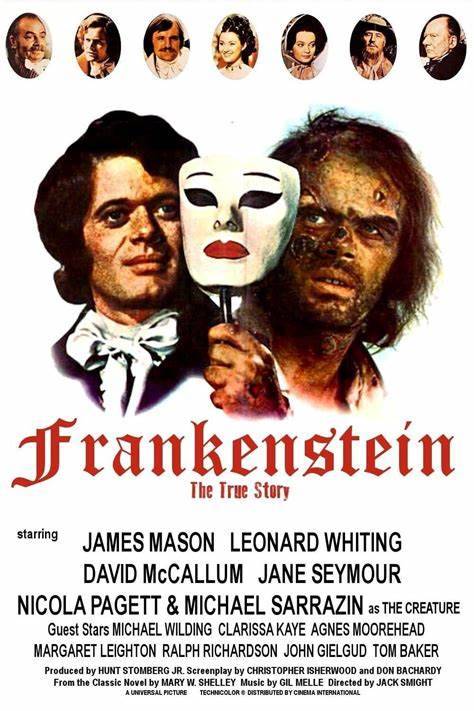
In this 1973 Two Part TV Movie ,Victor Frankenstein (Leonard Whiting ) ,after the death of his brother William becomes obsessed with bringing life from death teaming up with the sickly Henry Clerval (David McCallum)who has been experimenting on such a subject ,seeking to make man,however Clerval finds a flaw in their process but dies before he can tell Victor who uses Clervals mind for his creation ,a beautiful man (Michael Sarrazin),while a sinister figure named Polidori(James Mason ) seeks to use Victor and his creation for his own purposes
Now this is one of the most unique takes on Frankenstein I have ever seen .IT takes influence from every major Frankenstein before it .It takes from the book,the two James Whale films from the 30's and Hammers FRankenstein series ,but mix it all to be really its own thing .I love the twist of the creation being beautiful but deteriotaing into a more monstrus figure .The film is also heavilly queer coded ,the connection between Frankenstein and the creature is protrayed almost romantic,I think it is clear the monster is in love with Victor .Unlike other versions the Monster NEVER harms Victor ,his victims are either self defense ,accidental ,those who wronged him......OR in some cases seem to be jealousy .The queer themes I feel come the cleares when Elizabeth confronts the Monster near the end ,and I find it very apparent in the ending .Also there are some wonderfully twisted scenes
The films cast includes notable names as John Gielgud ,Agnes Moorhead ,Margaret LEighton ,Tom Baker (Pre Doctor Who ) ,Michael Wildling ,and I think the most notable is Ralph Richardson as a blind violinist ,all in good supporting roles .David McCalum steals his scenes as Victors desheveled colleague and mentor Clerval..Jane Seymor is wonderfully unnerving as Polidori and Frankensteins creation Prima .James Mason plays the purely villainous Polidori ,a take on Pretorious from Bride of Frankenstein ,and no surprise he makes for an entertaining villain .Nicola Paget is probabbly my favorite cast member ,being very meciinary in her goals to protect Victor from consequences and her disdain for the creature he created .Michael Sarrazin is VERY good as the creature,still having menacing moment but honestly selling the tragedy of the being .And at the head of the cast is Leonard Whiting as a young ambitious and tragic Frankenstein,and one of my favorite takes on him as he realizes his mistakes,and I am fascinated by him and his creatures relationship
I will say this was paced for TV to be aired on two nights so that might affect enjoyment it is a bit slow
OVerall,I love this film,might be a while before a rewatch but it is one of the best Frankenstein movies Ive seen
Oh it also inspired Interview with a vampire and I think thats neat
@ariel-seagull-wings @themousefromfantasyland @the-blue-fairie
@theancientvaleofsoulmaking @countesspetofi @princesssarisa
@amalthea9 @filmcityworld1 @barbossas-wench
7 notes
·
View notes
Text
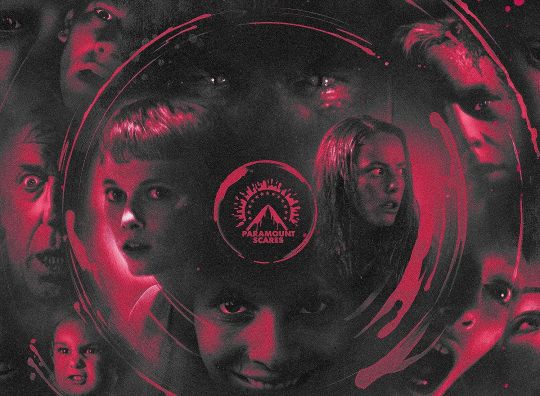
Paramount Scares: Volume One will be released on October 24 via Paramount. The 4K Ultra HD box set collects Rosemary's Baby, Pet Sematary, Crawl, Smile, and a mystery fifth title making its 4K UHD debut.
1968's Rosemary's Baby is written and directed by Roman Polanski, based on Ira Levin’s 1967 novel. Mia Farrow stars with John Cassavetes, Ruth Gordon, Sidney Blackmer, Maurice Evans, and Ralph Bellamy.
1989's Pet Sematary is based on the 1983 novel by Stephen King, who also penned the script. Mary Lambert (Urban Legends: Bloody Mary) directs. Dale Midkiff, Fred Gwynne, Denise Crosby, Brad Greenquist, and Miko Hughes star.
2019's Crawl is directed by Alexandre Aja (The Hills Have Eyes, High Tension) and written by Michael & Shawn Rasmussen (The Ward). Kaya Scodelario and Barry Pepper star. Sam Raimi produces.
2022's Smile marks the feature debut of writer-director Parker Finn, based on his 2020 short film Laura Hasn’t Slept. Sosie Bacon, Jessie T. Usher, Kyle Gallner, Caitlin Stasey, Kal Penn, and Rob Morgan star.
The limited edition set comes with an special issue of Fangoria magazine, Paramount Scares enamel pin, sticker sheet, and exclusive slipcovers for all five films. Special features are listed below.

Rosemary's Baby special features:
Rosemary’s Baby: A Retrospective
Mia and Roman
Theatrical trailer 50th anniversary trailer
Like most first-time mothers, Rosemary experiences confusion and fear. Her husband, an ambitious but unsuccessful actor, makes a pact with the devil that promises to send his career skyward.
Pet Sematary special features:
Audio commentary by director Mary Lambert
Interview with Mary Lambert
Fear and Remembrance
Stephen King Territory
The Characters
Filming the Horror
3 image galleries: storyboards (with introduction by Mary Lambert), behind the scenes, marketing
Dr. Louis Creed, having just moved to Maine with his wife and two children, is heartbroken when he finds that his daughter’s beloved cat has been hit by a truck and killed. Thankfully, a strange, elderly neighbor called Jud knows a secret that may spare the young girl’s tears. He takes the dead cat to an ancient Indian burial ground that lies hidden in the surrounding hilltops; and when he buries the feline there, it comes back to life a few days later. But Louis can’t be trusted with the secret, and, despite strong warnings that something horrible will happen, he uses the power of the burial ground to bring his son back from the dead.
Crawl special features:
Beneath Crawl featurette
Category 5 Gators: The VFX of Crawl featurette
Alligator Attacks
Alternate opening
Introduction to alternate opening
Deleted and extended scenes
As a category 5 hurricane tears through Florida, Haley rushes to find her father, who is injured and trapped in the crawl space of their home. The storm intensifies and water levels rise, just as the pair face an even more terrifying threat—alligators lurking below the surface, ready to chop.
Smile special features:
Audio commentary by writer-director Parker Finn
Laura Hasn’t Slept - Original short film with introduction by director Parker Finn
Something’s Wrong with Rose: Making Smile
Flies on the Wall: Inside the Score featurette
Deleted scenes with optional commentary by director Parker Finn
After witnessing a bizarre, traumatic incident involving a patient, Dr. Rose Cotter starts experiencing frightening occurrences that she can’t explain. As an overwhelming terror begins taking over her life, Rose must confront her troubling past in order to survive and escape her horrifying new reality.
Pre-order Paramount Scares: Volume One.
#rosemary's baby#pet sematary#crawl#smile#stephen king#horror#dvd#gift#paramount scares#parker finn#mary lambert#alexandre aja#mia farrow#sosie bacon#kaya scodelario
27 notes
·
View notes
Text
It´s more of a questionnaire than interview and it´s under the cut :-)
Penelope Wilton: ‘I was dyslexic. People thought I was stupid’
The actress on flower power, the Beatles and her star turn in Downton Abbey
First film I saw at the cinema
My mother used the cinema as her nanny. She had an arrangement with the usherette where she would go shopping and leave my sister and me at the cinema. When she had finished shopping she would come down the aisle and wave a white hanky — that was our sign to leave. Les Vacances de Monsieur Hulot was the first film I remember seeing. Jacques Tati was such a great clown.
First time I cried at the cinema
I don’t tend to cry over films. Usually I cry in front of paintings or at concerts. I did, however, sob through the film Brief Encounter. It’s so terribly touching. I still get a lump in my throat every time I watch it.
First time I performed on a stage
My first job was at 20, as Tammy the tightrope walker in a Christmas show at the Nottingham Playhouse. Theatre is always anxious-making and it gets worse when you’re older. There have been some funny things happening while I’ve been on stage, though. One audience member heckled Ralph Richardson and me over bad language during the play West of Suez when we performed in Brighton. Another acclaimed actor, who will remain nameless, was embarrassingly drunk on the stage once, forcing me to say his lines and mine. It was madness.
First TV show I watched
We didn’t have a television for a long time while I was a child. I think we had one for the coronation but then it seemed to go. It wasn’t until I was a bit older that I became aware of television, and even now I don’t seem to have much time to watch things, mainly because I’m busy acting in plays and TV shows like Downton Abbey, which was a wonderful experience. It was a surprise to us all, including the writer Julian Fellowes, that it was so successful here and everywhere. It was particularly lovely to work with Maggie Smith because she was one of the actors I had always admired. I would be very keen to come back to the show if it were to return. I can hardly leave it now.
First book I loved
I was dyslexic as a child, at a time when dyslexia wasn’t diagnosed. You didn’t get much help — people just thought you were stupid. My dyslexia seems to have got better with age, but when I was younger I was read to by my mother and my older sister rather than reading myself. The Wind in the Willows by Kenneth Grahame was a favourite.
First album I bought
Please Please Me by the Beatles. Growing up I listened to romantic music like Dionne Warwick on the radiogram in our sitting room. Nowadays I listen to more classical music, but I still have a soft spot for the Beatles. Sadly I lost that LP when we moved houses.
First concert I attended
The 1812 Overture by Tchaikovsky at the Royal Albert Hall when I was about ten. They had real cannons that went off. I only started going to concerts when I was older. My late husband, the [Roads to Freedom] actor Daniel Massey, was a great classical music fan. He taught me a lot about music, in particular jazz and Erroll Garner.
First pop-inspired fashion trends I adopted
Hotpants and thigh-length boots in bright pink suede. Once you went to drama school, you didn’t have any money and could do what you wanted looks-wise. It was all flower power then, so we would walk around with no shoes on, throwing flowers at each other. It was alternative but lovely.
First actor I admired
Michael Redgrave. I saw him give the most tremendous performance in Uncle Vanya at Chichester in 1963 when I was 17. Laurence Olivier was the Doctor. Together they were funny and heartbreaking. Redgrave was a wonderful actor and, more importantly, a wonderful man.
First moment I realised I wanted to be an actress
I went to a pantomime once and there was a whoosh and the curtain went up. There was this bright light and warm air came out. I thought, “I don’t know why I’m sitting in the dark here. I’d like to be up there.”
First famous person I met
Jonathan Miller when he came to Nottingham Playhouse to direct King Lear. I was a bit starstruck then, but meeting the royal family is the only time I get truly anxious.
First moment I realised I’d made it
Even at my age I don’t think I have. If you started, you wouldn’t be very good. So I will continue to try.
13 notes
·
View notes
Text
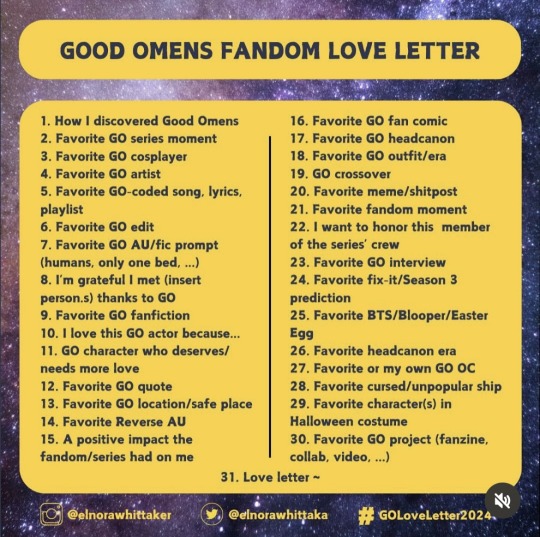
Day 22 - I want to honor this member of the series’ crew
Oh my gosh, Mickey Ralph. Who hand painted that washbasin. That nobody was ever going to get more than a glimpse of, just so that everything would be as close to identical as possible. That’s dedication.
Day 23 - Favorite GO interview
Of course I can’t find the link now, but the interview where David and Michael talk about Aziraphale and Crowley’s perfect date. :)
This is Elnora Whittaker's October challenge. If you decide to participate, please credit her!
3 notes
·
View notes
Text
SFX Magazine Issue 372 - Designing Good Omens ❤ 😊
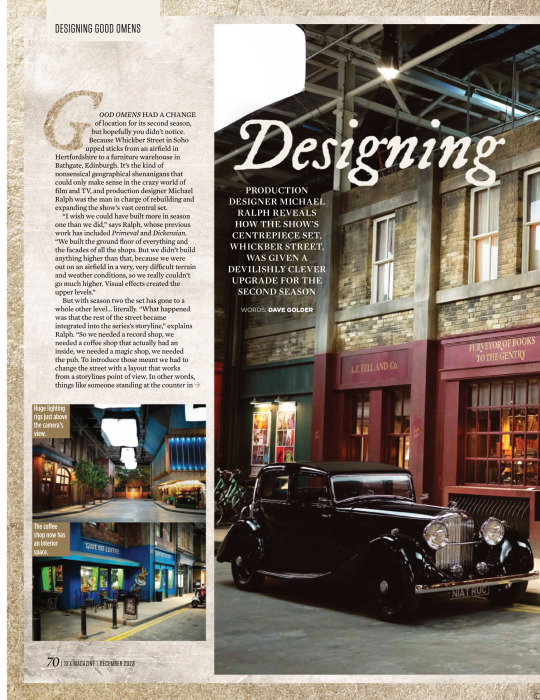
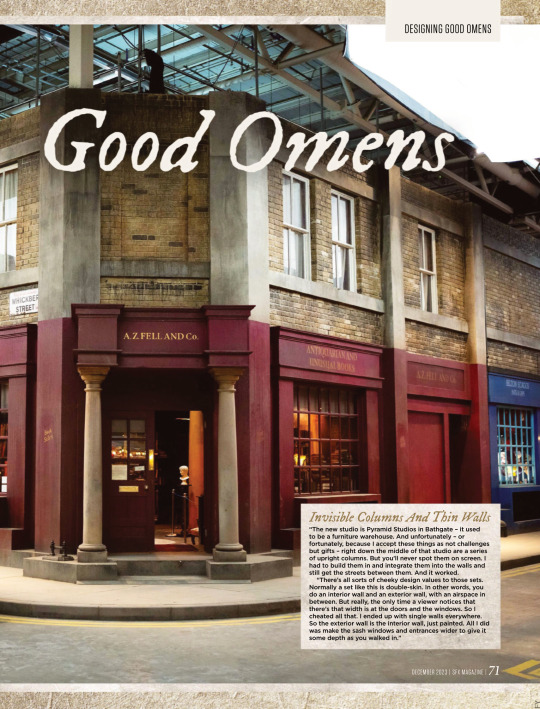

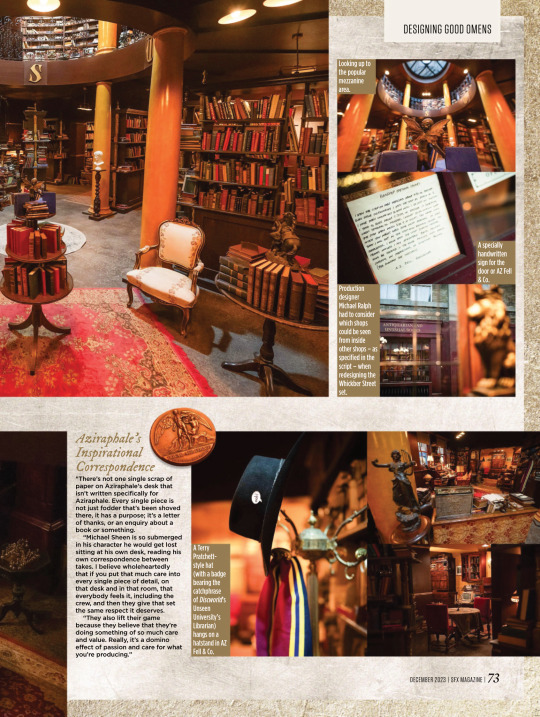
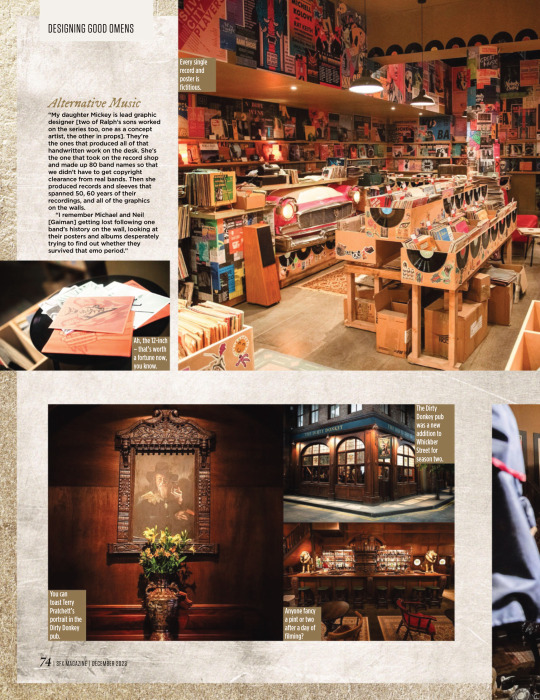

PRODUCTION DESIGNER MICHAEL RALPH REVEALS HOW THE SHOW’S CENTREPIECE SET, WHICKBER STREET, WAS GIVEN A DEVILISHLY CLEVER UPGRADE FOR THE SECOND SEASON
WORDS: DAVE GOLDER
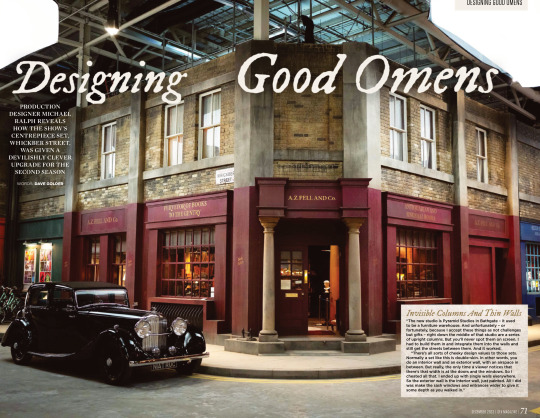
Invisible Columns And Thin Walls “The new studio is Pyramid Studios in Bathgate – it used to be a furniture warehouse. And unfortunately – or fortunately, because I accept these things as not challenges but gifts – right down the middle of that studio are a series of upright columns. But you’ll never spot them on screen. I had to build them in and integrate them into the walls and still get the streets between them. And it worked.
“There’s all sorts of cheeky design values to those sets. Normally a set like this is double-skin. In other words, you do an interior wall and an exterior wall, with an airspace in between. But really, the only time a viewer notices that there’s that width is at the doors and the windows. So I cheated all that. I ended up with single walls everywhere. So the exterior wall is the interior wall, just painted. All I did was make the sash windows and entrances wider to give it some depth as you walked in.”
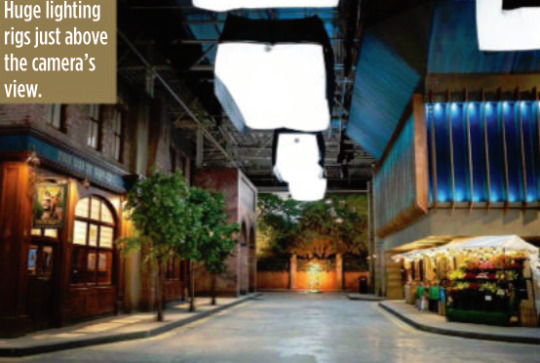
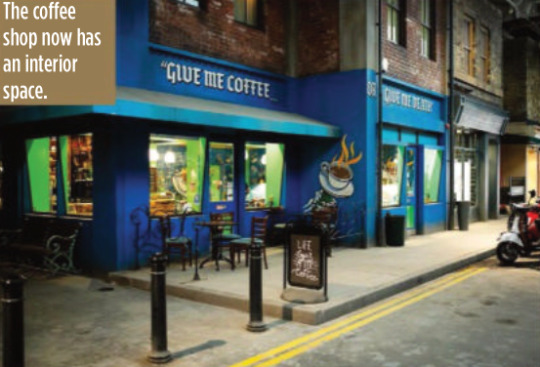
GOOD OMENS HAD A CHANGE of location for its second season, but hopefully you didn’t notice. Because Whickber Street in Soho upped sticks from an airfield in Hertfordshire to a furniture warehouse in Bathgate, Edinburgh. It’s the kind of nonsensical geographical shenanigans that could only make sense in the crazy world of film and TV, and production designer Michael Ralph was the man in charge of rebuilding and expanding the show’s vast central set. “I wish we could have built more in season one than we did,” says Ralph, whose previous work has included Primeval and Dickensian. “We built the ground floor of everything and the facades of all the shops. But we didn’t build anything higher than that, because we were out on an airfield in a very, very difficult terrain and weather conditions, so we really couldn’t go much higher. Visual effects created the upper levels.”
But with season two the set has gone to a whole other level… literally. “What happened was that the rest of the street became integrated into the series’s storyline,” explains Ralph. “So we needed a record shop, we needed a coffee shop that actually had an inside, we needed a magic shop, we needed the pub. To introduce those meant we had to change the street with a layout that works from a storylines point of view. In other words, things like someone standing at the counter in the record shop had to be able to eyeball somebody standing at the counter in the coffee shop. They had to be able to eyeball Aziraphale sitting in his office in the window of the bookshop. But the rest of it was a pleasure to do inside, because we could expand it and I could go up two storeys.”
For most of the set, which is around 80 metres long and 60 metres wide, the two storeys only applied to the shop frontages, but in the case of Aziraphale’s bookshop, it allowed Ralph to build the mezzanine level for real this time. According to Ralph it became one of the cast and crews’ favourite places to hang out during down time.
But while AZ Fell & Co has grown in height, it actually has a slightly smaller footprint because of the logistics of adapting it to the new studio.
“Everybody swore to me that no one would notice,” says Ralph wryly. “I walked onto it and instinctively knew there was a difference immediately, and they hated me for that. I have this innate sense about spatial awareness and an eye like a spirit level.
“It’s not a lot, though – I think we’ve lost maybe two and a half feet on the front wall internally. I think that there’s a couple of other smaller areas, but only I’d notice. So I can be really annoying to my guys, but only on those levels. Not on any other. They actually quite like me…”
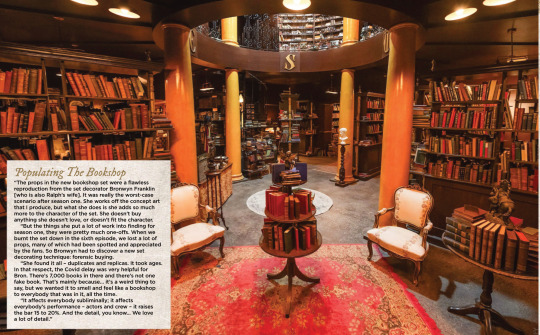
Populating The Bookshop “The props in the new bookshop set were a flawless reproduction from the set decorator Bronwyn Franklin [who is also Ralph’s wife]. It was really the worst-case scenario after season one. She works off the concept art that I produce, but what she does is she adds so much more to the character of the set. She doesn’t buy anything she doesn’t love, or doesn’t fit the character.
“But the things she put a lot of work into finding for season one, they were pretty much one-offs. When we burnt the set down in the sixth episode, we lost a lot of props, many of which had been spotted and appreciated by the fans. So Bronwyn had to discover a new set decorating technique: forensic buying.
“She found it all – duplicates and replicas. It took ages. In that respect, the Covid delay was very helpful for Bron. There’s 7,000 books in there and there’s not one fake book. That’s mainly because… it’s a weird thing to say, but we wanted it to smell and feel like a bookshop to everybody that was in it, all the time.
“It affects everybody subliminally; it affects everybody’s performance – actors and crew – it raises the bar 15 to 20%. And the detail, you know… We love a lot of detail.”
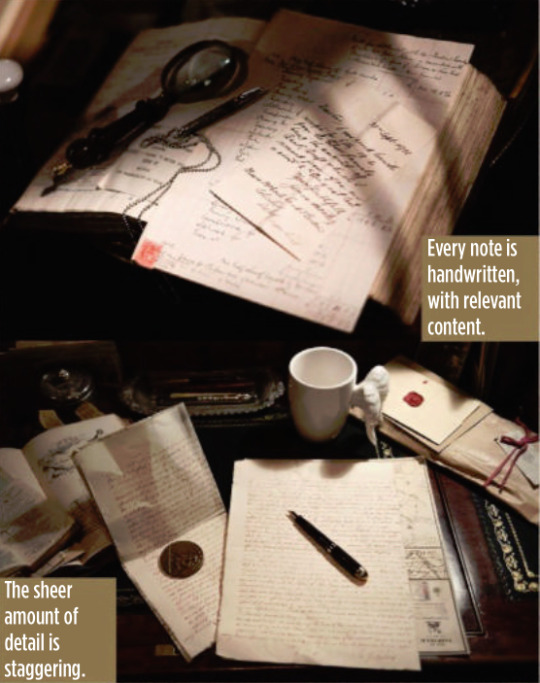
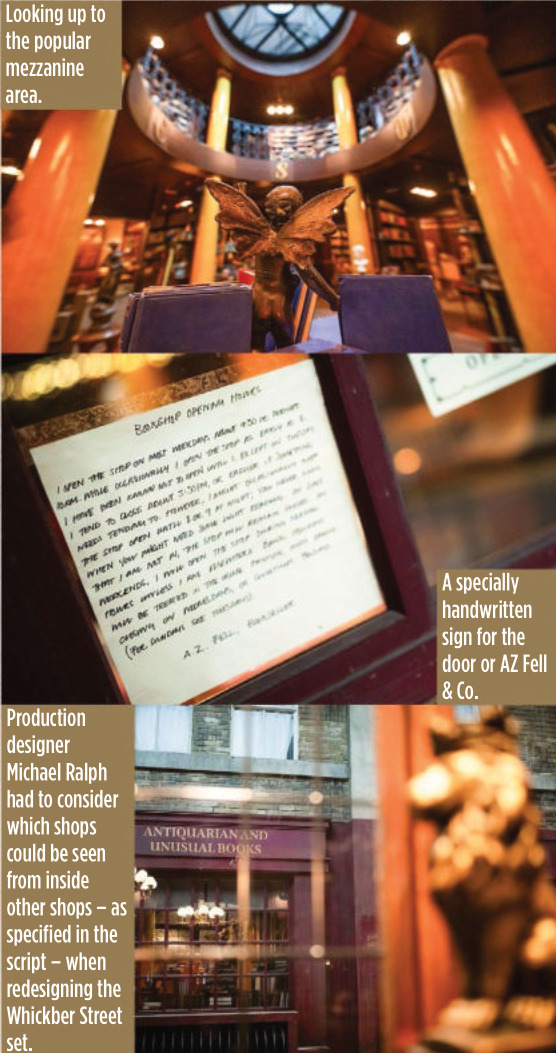
(look at the description under this, they called him 'Azi' hehehehe :D <3)
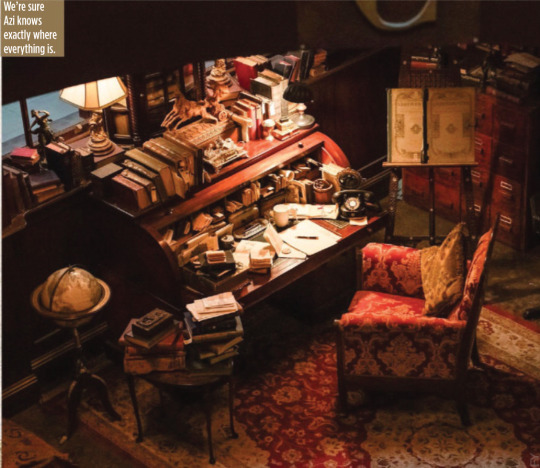
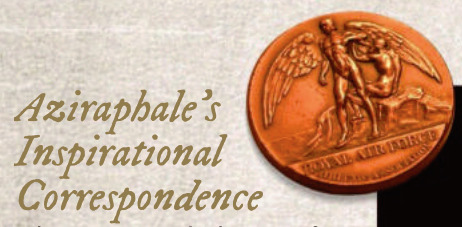
Aziraphale’s Inspirational Correspondence “There’s not one single scrap of paper on Aziraphale’s desk that isn’t written specifically for Aziraphale. Every single piece is not just fodder that’s been shoved there, it has a purpose; it’s a letter of thanks, or an enquiry about a book or something.
“Michael Sheen is so submerged in his character he would get lost sitting at his own desk, reading his own correspondence between takes. I believe wholeheartedly that if you put that much care into every single piece of detail, on that desk and in that room, that everybody feels it, including the crew, and then they give that set the same respect it deserves.
“They also lift their game because they believe that they’re doing something of so much care and value. Really, it’s a domino effect of passion and care for what you’re producing.”
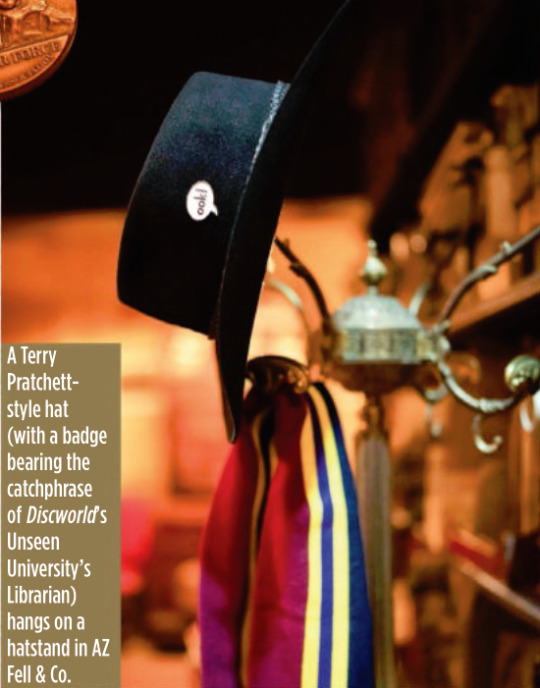
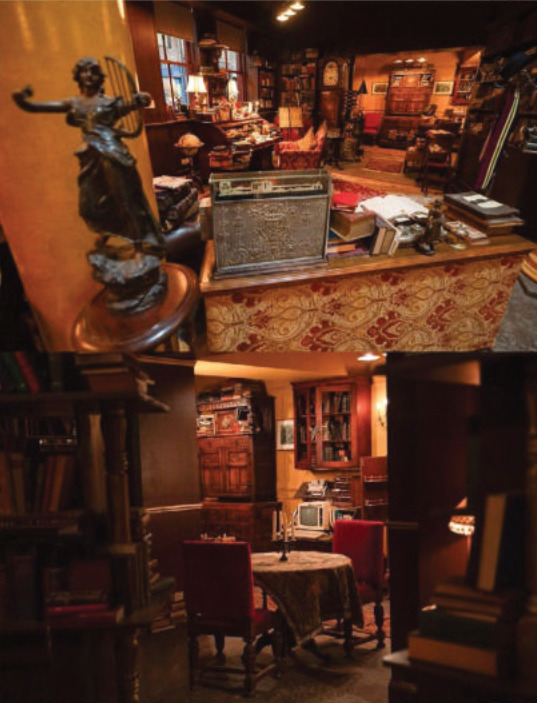

Alternative Music “My daughter Mickey is lead graphic designer [two of Ralph’s sons worked on the series too, one as a concept artist, the other in props]. They’re the ones that produced all of that handwritten work on the desk. She’s the one that took on the record shop and made up 80 band names so that we didn’t have to get copyright clearance from real bands. Then she produced records and sleeves that spanned 50, 60 years of their recordings, and all of the graphics on the walls.
“I remember Michael and Neil [Gaiman] getting lost following one band’s history on the wall, looking at their posters and albums desperately trying to find out whether they survived that emo period.”

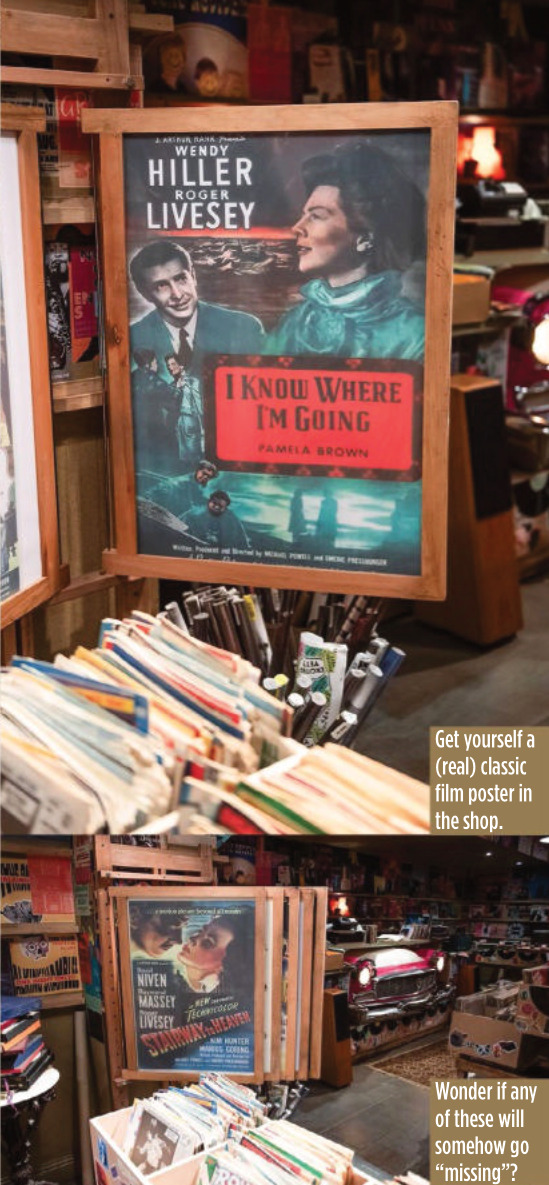

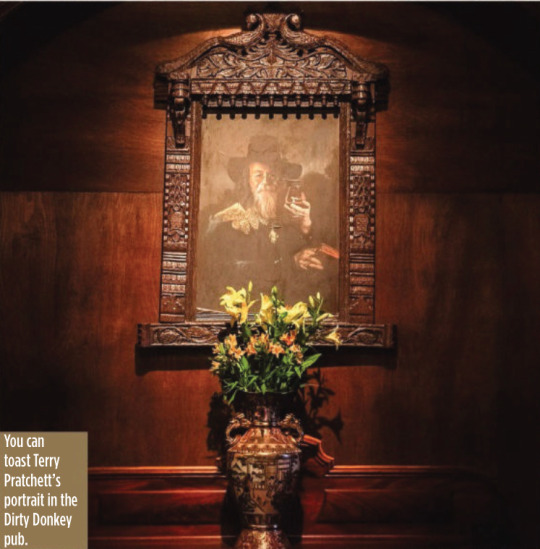

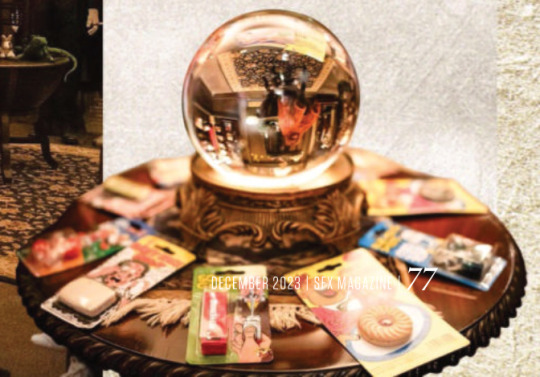
It’s A Kind Of Magic One of the new shops in Whickber Street for season two was Will Goldstone’s Magic Shop, which is full of as many Easter eggs as off-the-shelf conjuring tricks, including a Matt Smith Doctor Who-style fez and a toy orang-utan that’s a nod to Discworld’s The Librarian. Ralph says that while the series is full of references to Gaiman, Pratchett and Doctor Who, Michael Sheen never complained about a lack of Masters Of Sex in-jokes. “He’d be the last person to make that sort of comment!”
Ralph also reveals that the magic shop counter was another one of his wife’s purchases, bought at a Glasgow reclamation yard.
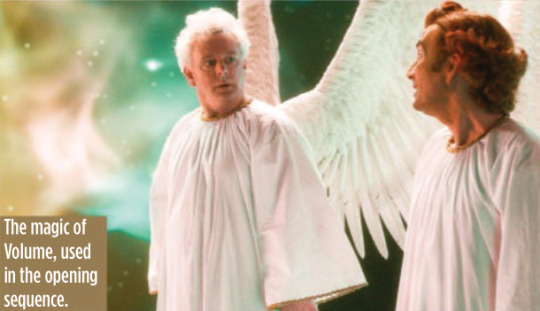
The Anansi Boys Connection Ralph reveals that Good Omens season two used the state-of-the-art special effects tech Volume (famous for its use in The Mandalorian to create virtual backdrops) for just one sequence, but he will be using it extensively elsewhere on another Gaiman TV series being made for Prime Video.
“We used Volume on the opening sequence to create the creation of the universe. I was designing Anansi Boys in duality with this project, which seems an outrageously suicidal thing to do. But it was fantastic and Anansi Boys was all on Volume. So I designed for Volume on one show and not Volume on the other. The complexities and the psychology of both is different.”
#good omens#gos2#season 2#photos#bts#bts photos#interview#sfx magazine#magazines#hq photos#neil gaiman#terry pratchett#michael sheen#david tennant#michael ralph#mickey ralph#bronwyn franklin#anansi boys#the small back room#maggie's record shop#soho#aziraphale's bookshop#dirty donkey#magic shop#aziraphale's correspondence#give me coffee or give me death#fun fact#michael ralph interview#sfx 372 magazine#s2 interview
4K notes
·
View notes
Text

❤︎ = my favorites atm
Barry
✦ Barry Berkman
✧ Sally Reed
✦ NoHo Hank ❤︎
✧ Cristobal Sifuentes
Batman Villains
✦ Harley Quinn
✧ Harvey Dent
✦ Jonathan “Scarecrow” Crane
✧ Oswald “The Penguin” Cobblepot
✦ Pamela “Poison Ivy” Isley
✧ Selina “Catwoman” Kyle ❤︎
✦ The Joker
✧ Victor “Mr. Freeze” Fries
Bullet Train
✦ Ladybug
✧ Lemon ❤︎
✦ Tangerine ❤︎
✧ Yuichi Kimura
Detroit: Become Human
✦ Connor | RK800
✧ Nines | RK900
✦ Sixty | RK800-60 ❤︎
✧ Hank Anderson
✦ Gavin Reed ❤︎
✧ Tina Chen
✦ Chris Miller
✧ Daniel | PL600
✦ Kara | AX400
✧ Luther | TR400
✦ Ralph | WR600
✧ Jerry | EM400
✦ Markus | RK200 ❤︎
✧ Simon | PL600
✦ North | WR400
✧ Josh | PJ500
Good Omens
✦ Aziraphale
✧ Crowley
✦ Gabriel
✧ Beelzebub
✦ Anathema Device
Gotham
✦ Jim Gordon
✧ Harvey Bullock
✦ Harvey Dent
✧ Lucius Fox
✦ Leslie “Lee” Thompkins ❤︎
✧ Bruce Wayne (Season 5)
✦ Selina Kyle (Seasons 4-5)
✧ Ivy Pepper (Seasons 3-5)
✦ Barbara Kean
✧ Tabitha Galavan
✦ Butch Gilzean
✧ Fish Mooney
✦ Oswald Cobblepot
✧ Edward Nygma/The Riddler ❤︎
✦ Sofia Falcone
✧ Victor Zsasz ❤︎
✦ Jerome Valeska
✧ Jeremiah Valeska
✦ Jervis Tetch
✧ Victor Fries
✦ Bridgit Pike
Interview With The Vampire (2022)
✦ Louis de Pointe du Lac
✧ Lestat de Lioncourt
✦ Daniel Molloy
✧ Claudia
✦ Armand
iZombie
✦ Olivia “Liv” Moore
✧ Lowell Tracy
✦ Ravi Chakrabarti ❤︎
✧ Clive Babineaux
✦ Dallas Anne “Dale” Bozzio
✧ Major Lillywhite ❤︎
✦ Chase Graves ❤︎
✧ Peyton Charles ❤︎
✦ Blaine DeBeers
✧ Don “Don E.” Eberhard
Mayans M.C
✦ Ezekiel “EZ” Reyes
✧ Angel Reyes ❤︎
✦ Obispo “Bishop” Losa ❤︎
✧ Johnny “El Coco” Cruz
✦ Gilberto “Gilly” Lopez
✧ Michael “Riz” Ariza
✦ Guero
✧ Bottles ❤︎
✦ Miguel Galindo
✧ Emily Thomas
Our Flag Means Death
✦ Stede Bonnet
✧ Marry Bonnet
✦ Evelyn Higgins
✧ Edward “Blackbeard/The Kraken” Teach ❤︎
✦ Israel “Izzy” Hands ❤︎
✧ John “Calico Jack” Rackham
✦ Fang
✧ Ivan
✦ Oluwande Boodhari ❤︎
✧ Jim Jimenez
✦ Spanish Jackie
✧ Lucius Spriggs
✦ Black Pete
✧ Frenchie ❤︎
✦ Wee John Feeney
✧ Roach
✦ The Swede
The Fall of the House of Usher
✦ Tamerlane Usher
✧ Victorine LaFourcade
✦ Napoleon “Leo” Usher ❤︎
✧ Camille L’Espanaye
✦ Prospero “Perry” Usher
The Umbrella Academy
✦ Luther Hargreeves
✧ Diego Hargreeves
✦ Lila Pitts
✧ Allison Hargreeves
✦ Ray Chesnut
✧ Klaus Hargreeves
✦ Ben Hargreeves ❤︎
✧ Viktor Hargreeves
Venom (2018)
✦ Eddie Brock
✧ Venom
✦ Anne Weying
✧ Carlton Drake
✦ Dora Skirth
What We Do In The Shadows
✦ Guillermo de La Cruz
✧ Nandor the Relentless
✦ Laszlo Cravensworth ❤︎
✧ Nadja of Antipaxos
✦ Colin Robinson
✧ The Guide
✦ The Djinn ❤︎
✧ Marwa
✦ Sean Rinaldi
✧ Vladislav
✦ Viago Von Heimburg ❤︎
✧ Deacon Brüke
✦ Anton
3 notes
·
View notes
Text
John Amos on “Good Times:” The First Black TV Dad
John Amos broke ground when he played the first African American TV dad and family man on “Good Times.”
The show was created by Eric Monte and Mike Evans and produced by Norman Lear as a spinoff of “Maude,” itself a spinoff of “All in the Family,” and premiered Friday, February 8, 1974 on CBS, starring Esther Rolle.

“Good Times” cast on the cover of the December 14-20, 1974 edition of “TV Guide.”
Rolle (born 1920, Florida) originated the role of Florida Evans in the third episode of “Maude,” first aired Tuesday, September 26, 1972. She played the newly-hired housekeeper of Bea Arthur’s Maude Findlay, cousin to Jean Stapleton’s Edith Bunker on “All in the Family.”
Amos (born 1939, New Jersey) made his first appearance as Florida’s husband, originally Henry Evans, in the 18th episode of “Maude” first aired Tuesday, February 13, 1973.
youtube
John Amos debuts in “Maude,” opposite Bea Arthur and Esther Rolle. (CBS)
“Maude” and “All in the Family” producer Norman Lear approached Rolle to star in a CBS television pilot to develop a show around Florida.
Rolle accepted the offer, conditioned that Amos would continue in his role as her husband in the new series. The actress insisted that the show, which would be the first television sitcom to feature an African American nuclear family, have a father.
She made her final appearance on “Maude” on the Tuesday that preceded the first episode of “Good Times” that aired the following Friday, starring Rolle and Amos, and Amos’ Henry Evans became James Evans Sr.
By the time the second season of “Good Times” premiered Tuesday, September 10, 1974, it became one of the most watched shows in U.S. prime time television.
youtube
“Good Times” title sequence for season one. (CBS)
On “Good Times,” Rolle and Amos’ characters become working-class people who live in a Chicago public housing project. Amos’ James becomes an itinerant day laborer, unlike his “Maude” occupation as a firefighter, who struggles to lift his family out of poverty, and Rolle’s Florida a homemaker.
Jimmie Walker, who played the Evans’ firstborn son James Jr. or J.J., became the show's breakout star, much to the chagrin of Rolle and Amos. Amos’ disagreement with showrunners prompted Lear to dismiss him after season three.
youtube
John Amos interviewed in 2014 for the Archive of American Television. (Television Academy)
Producers killed Amos’ character at the start of season four in the two-part episode, “The Big Move,” first aired September 22 and September 29, 1976 on CBS.
The episode’s second part features the repast after James’ funeral, and produced one of Rolle’s most memorable performances as Florida.
Florida cleans up after friends depart her home, and she soon breaks down in inconsolable grief, as kids J.J., Thelma (Bern Nadette Stanis), and Michael (Ralph Carter) rush to comfort her.
youtube
Esther Rolle in “Good Times.” (CBS)
Rolle, too, left “Good Times,” at the end of season four, like Amos expressing displeasure at the show’s direction. Viewership dropped precipitously following Rolle’s departure.
In Rolle’s stead, the show elevated Ja’Net DuBois’ supporting role as neighbor Willona Woods to main star for its fifth season, and added ingenue Janet Jackson to the cast.
Florida returns to the canvas when Esther Rolle agreed to rejoin the show for its sixth and final season, conditioned on concessions from showrunners on its direction.
Rolle closed out “Good Times” in its finale first aired Friday, August 1, 1979 on CBS. Her career continued until her death in 1998.
youtube
John Amos appears in the 2019 “Good Times” special. (ABC)
Amos reunited with “Good Times” cast members in 2007 to accept a TV Land Award for the show. In 2019, he participated in a special revival of the show produced by Norman Lear on ABC, with James and Florida played by Andre Braugher and Viola Davis.
3 notes
·
View notes
Note
So I watched Crossroads because I remember you mentioned that the way Daniel looks in (the very early parts of) Knights and Pawns was drawn from this movie. I actually ended up really liking it, and thoroughly enjoying the music! But I have to be honest: pretty as Macchio is there (and when is he not?) his hair was NOT IT in this film lmao. I hated the style of it here so much omg lol. I know some have mentioned picturing Pawnverse!Daniel as looking like he did in the Outsiders interview, which I'm fine with because he looks like an angel there...but I've always pictured him as looking like he did as Teddy. He actually looks like a teenager there, and that floppy hair!!! The doe-eyes!!! The pout!!! I cannottttttttttttt.
I guess KK3!Terry will do for the earlier years too. He's so slimy but so handsome lol.
For me it's more about the sass, Nonnie. I mean the Teddy hair with Ralph as himself in the interviews, say, that's fine too, but I personally only picture him like Teddy in the time after they return from Sicily, when Daniel is an emotional open wound and doesn't even has his anger to shield him. (Maybe he showed his family that side a little before, too.) When he needs Terry to act as he shield instead. I think the first time Michael and Apollonia come to his house together he falls into Michael's arms as if they were Terry's and greets Apollonia like a long lost sister, which makes her go, in what little English she has by then: "You sit, I make food."
"No,va bene, non è necessario -"
"You sit! I make food!"
Like, Daniel -as - Teddy makes everyone around him go: "uhoh. We done fucked up."
Terry has somewhat shorter hair than in TKK3, but he does use a lot of pommade. Of course there's not enough of that stuff in the world to keep all his curls in check and Daniel likes to twirl his fingers in the ones that come loose, which makes Terry all soft, especially since his small pups do the same (only they pull).
2 notes
·
View notes
Text

Acknowledgments
This book could not have been written without Eunice. She watched and transcribed everything from professional wrestling, to reality television shows, to the scenes described in the chapter on pornography. She edited and rewrote passages. She clarified incomplete thoughts, challenged shaky assertions, and added paragraphs that always enhanced the points I was trying to make. She stayed up many nights long after I had gone to bed, reworking sections of the book. Nothing I write is published before it goes through her hands. Our marriage is a rare combination of spiritual and intellectual affinity. “She’is all States, and all Princes, I, Nothing else is,” as John Donne wrote in his poem “The Sunne Rising”:
Princes doe play us; compar’d to this,All honor’s mimique; all wealth alchimie.Thou, sunne, art halfe as happy’as wee,In that the world’s contracted thus.
I am deeply indebted to The Nation Institute and the Lannan Foundation. The support of these organizations permitted me to write this book. I am especially grateful to Hamilton Fish, Ruth Baldwin, Taya Grobow, and Jonathan Schell, as well as Peggy Suttle and Katrina vanden Heuvel at The Nation magazine. Carl Bromley at Nation Books is a remarkably talented and brilliant editor, a fine writer and scholar in his own right, who helped shape and guide this book. In an age when editing seems to be a dying art, he upholds the highest standards of the craft. He loves books and ideas, and his insight and enthusiasm are infectious. It was a privilege to work with him. Michele Jacob, whom I have worked with before, handled publicity and book events with her usual efficiency. Patrick Lannan and Jo Chapman at the Lannan Foundation have been constant and steadfast supporters of my work. It was Patrick, who has done more than perhaps anyone in the country to nurture, promote, and protect great writing, who first gave me Sheldon Wolin’s Democracy Incorporated.
The Reverend Coleman Brown, my professor of religion at Colgate University and mentor, once again guided me through the writing. Coleman generously shared his profound wisdom, at once always humbling and always correct. His voice of compassion and deep insight into the human condition serve to temper the tone of my writing and pull me back from the edge of despair to remind me, and my readers, that good exists and is never as powerless as it appears.
John Timpane, a fellow lover of books, poetry, and theater, again edited the final manuscript. All my final manuscripts end up in his hands at my request. John, the greatest line and content editor in the business, is the Olympian authority who makes the last decisions on what is in or out, what should be changed and what amended. No writer could be in better hands, even if he has a hard time accepting my supremacy at Balderdash.
Chris Hebdon, a student at Berkeley, worked tirelessly on the book. He attended the seminar on positive psychology, did all the interviews and recordings, and wrote up the proceedings. The chapter on positive psychology is largely his work. Chris is a very talented young man whose conscience is as impressive as his intellect, which must make some of his professors very uncomfortable. My son Thomas, whose integrity is matched by a superb intellect, as well as a maturity and sensitivity that extend far beyond his years, worked during his Christmas vacation from Colgate University on the book in the Princeton University library. Robert Scheer and Zuade Kaufmann, who run the Web magazine Truthdig, where I write a weekly column, care deeply about maintaining the standards of great writing and reporting. I am fortunate to count them as friends and write for their site. Gerald Stern, Anne Marie Macari, Mae Sakharov, Rick McArthur, Richard Fenn, James Cone, Ralph Nader, Maria-Christina Keller, Pam Diamond, June Ballinger, Michael Goldstein, Irene Brown, Margaret Maurer, Sam Hynes, Tom Artin, Joe Sacco, Steve Kinzer, Charlie and Catherine Williams, Mark Kurlansky, Ann and Walter Pincus, Joe and Heidi Hough, Laila al-Arian, Michael Granzen, Karen Hernandez, Ray Close, Peter Scheer, Kasia Anderson, Robert J. Lifton, Lauren B. Davis, Robert Jensen, Cristina Nehring, Bernard Rapoport, Jean Stein, Larry Joseph, Wanda Liu (our patient and skillful Mandarin tutor), as well as Dorothea von Molke and Cliff Simms, who together run one of the finest bookstores in America, are part all of our cherished circle. Cliff was one of the most prescient critics of the manuscript and greatly improved its sharpness and focus. Thanks as well to Boris Rorer, Michael Levien, who recommended David Foster Wallace’s brilliant essay on the porn industry, and the staff at Bon Appetit, where I buy my daily baguette.
Lisa Bankoff of International Creative Management, as she has for all my books, negotiated contracts and eased the maddening minutiae of putting this book together. I am fortunate to be able to work with her.
My children, Thomas, Noëlle, and Konrad, are my greatest joy. After years in which I have witnessed too much violent death and suffering, they are the balms to my soul, the gentle reminders that trauma can be slowly healed through love and that redemption is possible.
Bibliography
ABC News. Living in the Shadows: Illiteracy in America. Feb. 25, 2008. Adorno, Theodor. The Culture Industry. London: Routledge, 1991. Andrejevic, Mark. Reality TV: The Work of Being Watched. Toronto: Rowman & Littlefield, 2004.
Arendt, Hannah. On Revolution. London: Penguin, 1963.
———. The Origins of Totalitarianism. New York: Harcourt, 1966.
Arnold, Matthew. Culture and Anarchy. New Haven, Conn.: Yale University Press, 1994.
Bacevich, Andrew J. The Limits of Power: The End of American Exceptional-ism . New York: Metropolitan, 2008.
Bakan, Joel, writer. The Corporation: The Pathological Pursuit of Profit and Power. Canada: Big Picture Media Corporation/Zeitgeist Films, 2003.
Barstow, David. “One Man’s Military-Industrial-Media Complex.” New York Times (Nov. 29, 2008). http://www.nytimes.com/2008/11/30/washington/30general.html.
Benjamin, Walter. “The Work of Art in the Age of Mechanical Reproduction.” Marxists.org. http://www.marxists.org/reference/subject/philosophy/works/ge/benjamin.htm.
Bernays, Edward. Propaganda. New York: Ig Publishing, 1928.
Bernstein, Paul. Workplace Democratization: Its Internal Dynamics. New Brunswick, N.J.: Transaction Books, 1976.
Berry, Wendell. The Unsettling of America. San Francisco: Sierra Club, 1977.
———. The Way of Ignorance. Washington, D.C.: Shoemaker & Hoard, 2005.
Boorstin, Daniel J. The Image: A Guide to Pseudo-Events in America. New York: Atheneum, 1961.
Bradbury, Ray. Fahrenheit 451. New York: Del Rey, 1996.
Bradley, James. Flags of Our Fathers. New York: Bantam, 2000.
Briggs, Asa, and Peter Burke. A Social History of the Media: From Gutenberg to the Internet. Cambridge: Polity, 2005.
“Canada’s Shame.” The National. Canadian Broadcasting Company. May 24, 2006.
Cantor, Paul A. “Pro Wrestling and the End of History.” The Weekly Standard 5:3 (Oct. 4, 1999): 17–22.
Chamberlin, Jamie. “Reaching ‘Flow’ to Optimize Work and Play.” American Psychological Association Monitor 29:7 (July 1998). http://www.apa.org/monitor/ju198/joy.html.
Cochran, Chris. “The Production of Cultural Difference: Paradigm Enforcement in Cultural Psychology.” Psychology at Berkeley 1 (Spring 2008): 62–73.
Colvin, Randall, and Jack Block. “Do Positive Illusions Foster Mental Health? An Examination of the Taylor and Brown Formulation.” Psychological Bulletin 116:. 1: 3–20.
Conrad, Joseph. Heart of Darkness. London: Penguin, 1902.
Cooper, Marc. The Last Honest Place in America: Paradise and Perdition in the New Las Vegas. New York: Nation, 2004.
Crane, Richard Teller. The Utility of all Kinds of Higher Schooling. Chicago: H. O. Shepard, 1909.
Csikszentmihály, Mihály. “Brain Channels Thinker of the Year Award: 2000: Mihály Csikszentmihály, ‘Flow Theory.’” Brain Channels. Accessed April 5, 2009. http://www.brainchannels.com/thinker/mihaly.html
D’Ambrosio, Antonino. A Heartbeat and a Guitar: Johnny Cash and the Making of Bitter Tears. New York: Nation Books, 2009.
De Botton, Alain. Status Anxiety. New York: Pantheon, 2004.
DeMott, Benjamin. Junk Politics. New York: Nation, 2003.
Deresiewicz, William. “The Disadvantages of an Elite Education.” The American Scholar (Summer 2008). http://www.theamericanscholar.org/the-disadvantages-of-an-elite-education.
———. “The End of Solitude.” The Chronicle of Higher Education 55:21 (Jan. 30, 2009). http://wwww.chronicle.com/free/v55/i21/21b00601.htm.
Diamond, Jared. Collapse. New York: Penguin, 2005.
Dines, Gail. “The White Man’s Burden: Gonzo Pornography and the Construction of Black Masculinity.” Yale Journal of Law and Feminism 18 (2006): 283–297.
“The Directors.” Adult Video News (August 2005): 54.
Donoghue, Frank. The Last Professors: The Corporate University and the Fate of the Humanities. New York: Fordham University Press, 2008.
Dworkin, Andrea. Pornogrpahy: Men Possessing Women. New York: Plume, 1979.
Eakin, Emily. “Greeting Big Brother with Open Arms.” New York Times (Jan . 17, 2004): B9+.
Eco, Umberto. Travels in Hyperreality. New York: Harcourt, 1983.
Eggers, Dave. A Heartbreaking Work of Staggering Genius. New York: Vintage, 2000.
Ellul, Jacques. Propaganda: The Formation of Men’s Attitudes. New York: Vintage, 1965.
Fromm, Erich. Escape From Freedom. New York: Henry Holt, 1941.
Fulbright, William J. The Pentagon Propaganda Machine. New York: Vintage, 1985.
Füredi, Frank. Where Have All the Intellectuals Gone?: Confronting 21st Century Philistinism. London: Continuum, 2004.
Gabler, Neal. Life: The Movie: How Entertainment Conquered Reality. New York: Vintage, 1998.
Gag Factor. http://www.gagfactor.com/gagfactordotcom.html.
Gates, Jeff. Democracy At Risk: Rescuing Main Street from Wall Street. Cambridge: Perseus Publishing, 2000.
Golden, Daniel. The Price of Admission: How America’s Ruling Class Buys Its Way into Elite Colleges—and Who Gets Left Outside the Gates. New York: Random House, 2006.
González, Roberto. “Brave New Workplace: Cooperation, Control, and the New Industrial Relations.” In Nader, Laura, et al., Controlling Processes: Selected Essays, 1994-2005. The Kroeber Anthropological Society Papers, 92/93 (2005): 107–127.
Grossman, Vasily. Life and Fate. Trans. Robert Chandler. New York: Harper and Row, 1985.
Gyrna, Frank M., Jr. Quality Circles: A Team Approach to Problem Solving. New York: American Management Associations, 1981.
Hedges, Chris. American Fascists: The Christian Right and the War on America . New York: Free Press, 2006.
Held, Barbara S. The Loss of Happiness in Market Democracies. New Haven, Conn: Yale University Press, 2002.
———. “Tyranny of the Positive Attitude in America: Observation and Speculation.” Journal of Clinical Psychology 58: 965–991.
Herrick, Neal Q. Joint Management and Employee Participation: Labor and Management at the Crossroads. San Francisco: Jossey-Bass, 1990.
Hoggart, Richard. The Uses of Literacy. New Brunswick: Transaction Publishers, 1998.
Huxley, Aldous. Brave New World. London: Triad Grafton, 1932.
Jensen, Robert. Getting Off: Pornography and the End of Masculinity. Cambridge, Mass.: South End, 2007.
Johnson, Chalmers. The Sorrows of Empire: Militarism, Secrecy, and the End of the Republic. New York: Henry Holt, 2004.
Johnston, David Cay. Free Lunch: How the Wealthiest Americans Enrich Themselves at Government Expense (And Stick You With the Bill). New York: Penguin, 2007.
Kamata, Satoshi. Japan in the Passing Lane: An Insider’s Account of Life in a Japanese Auto Factory. Tatsuru Akimoto, ed. and trans. New York: Pantheon, 1982.
Keller, Josh. “For Berkeley’s Sports Endowment, a Goal of $1 Billion.” The Chronicle of Higher Education, Jan. 23, 2009. http://chronicle.com/weekly/v55/i20/20a01301.htm.
Kindleberger, Charles P., and Robert Aliber. Manias, Panics, and Crashes. Hoboken, N.J.: John Wiley & Sons, 1978.
Kirp, David L. Shakespeare, Einstein, and the Bottom Line: The Marketing of Higher Education. Cambridge, Mass.: Harvard University Press, 2003.
Korten, David C. When Corporations Rule the World. San Francisco: Berrett-Koehler, 1995.
Lazarus, Richard S. “The Lazarus Manifesto for Positive Psychology and Psychology in General.” Psychological Inquiry, 14:2 (2003): 173–189.
Lippmann, Walter. Public Opinion. New York: Simon & Schuster, 1997.
Lubben, Shelley, and Jersey Jaxin. “Jersey Jaxin on Why She Quit Porn.” YouTube. Accessed Aug. 12, 2007. Part 1: http://www.youtube.com/watch?v=ACLK5ccKfM.
———. Part 2. http://www.youtube.com/watch?v=U1NObcJV8r0&feature=related.
Lugo, Alejandro. 1990. “Cultural Production and Reproduction in Ciudad Juárez, Mexico: Tropes at Play among Maquiladora Workers.” Cultural Anthropology. 5:2 (1990): 173–196.
MacArthur, John R. You Can’t Be President: The Outrageous Barriers to Democracy in America. New York: Melville House, 2008.
MacKay, Charles. Extraordinary Popular Delusions and the Madness of Crowds. New York: BN Publishing, 2008.
Mellman, Seymour. The Permanent War Economy: American Capitalism in Decline. New York: Simon & Schuster, 1985.
Mills, C. Wright. The Power Elite. New York: Oxford University Press, 1956.
Nader, Laura. “Controlling Processes: Tracing the Dynamic Components of Power.” Mintz Lecture. Current Anthropology, 38:5 (1997): 711–737.
———. “Harmony Coerced is Freedom Denied.” The Chronicle of Higher Education, July 13, 2001: 613–616
———. Harmony Ideology. Palo Alto: Stanford University Press, 1990.
———. Personal communication with Chris Hedges. Feb. 27, 2009.
Nader, Laura, and Ugo Mattei. Plunder: When the Rule of Law Is Illegal. Hoboken, N.J.: Blackwell Publishers, 2008.
Newport, Cal. How to Win at College. New York: Broadway, 2005.
Nevin, Thomas R. Simone Weil: Portrait of a Self-Exiled Jew. Chapel Hill: University of South Carolina Press, 1991.
“The New Industrial Relations.” Business Week 2687 (May 11, 1981): 84–89.
Noble, David. America by Design. Oxford: Oxford University Press, 1977.
Ofshe, R., and Margaret T. Singer. “Attacks on Peripheral versus Central Elements of Self and the Impact of Thought Reforming Techniques.” Cultic Studies. Journal, 3:1 (1986): 3–24.
Ortega y Gasset, José. The Revolt of the Masses. New York: W. W. Norton, 1932.
Orwell, George. 1984. New York: Signet, 1990.
———. The Collected Letters, Essays and Journalism of George Orwell. Vol, 4: In Front of Your Nose, 1945-1950. Eds. Sonia B. Orwell and Ian Angus. Boston: David R. Godine, 2000.
Ozaki, Robert S. Human Capitalism: The Japanese Enterprise System as World Model. Tokyo: Kodansha International, 1991.
Parker, Mike. Inside the Circle: A Union Guide to QWL. Boston: South End, 1985.
Peterson, C. “The Future of Optimism.” American Psychologist 55 (January 2000): 44–55.
Plato. The Republic. Translated by Robin Waterfield. Oxford: Oxford University Press, 1998.
Polanyi, Karl. The Great Transformation: The Political and Economic Origins of Our Time. Boston: Beacon Press, 1944.
Postman, Neil. Amusing Ourselves to Death: Public Discourse in the Age of Show Business. New York: Penguin, 1985.
Riesman, David. The Lonely Crowd: A Study of the Changing American Character . New Haven, Conn.: Yale University Press, 1950.
Rojek, Chris. Celebrity. London: Reaktion Books, 2001.
Roth, Joseph. The Emperor’s Tomb. New York: Overlook Press, 2002
Saul, John Ralston. The Unconscious Civilization. New York: Free Press, 1995.
———. Voltaire’s Bastards: The Dictatorship of Reason in the West. New York: Vintage, 1992.
Schmitt, Eric. “Pentagon Managers Find ‘Quality Time’ on a Brainstorming Retreat.” New York Times (Jan. 11, 1994): A7.
Schurmann, Reiner, ed. The Public Realm: Essays on Discursive Types in Political Philosophy. Albany: State University of New York Press, 1989.
Schwartz, Charles. Home page. http://socrates.berkeley.edu/~schwrtz.
Schwartz, Charles. “Good Morning, Regents.” UniversityProbe.org. http://universityprobe.org/2009/02/good-morning-regents.
Seligman, Martin. Authentic Happiness: Using the New Positive Psychology to Realize Your Potential for Lasting Fulfillment. New York: Free Press, 2002.
Simon, Scott, host. “Promoting Healthcare for the Porn Industry.” Weekend Edition. National Public Radio. Dec. 8, 2007. http://www.npr.org/templates/story/story.php?storyId=17044239.
Snow, C. P. The Two Cultures. Cambridge: Cambridge University Press, 1998.
Soares, Joseph A. The Power of Privilege: Yale and America’s Elite Colleges. Stanford, Calif.: Stanford University Press, 2007.
Stoller, Robert J., and I. S. Levine. Coming Attractions: The Making of an X-Rated Video.. New Haven, Conn: Yale University Press, 1993.
Taylor, S. E. “Adjustment to threatening events: A theory of cognitive adaptation.” American Psychologist 38 (1983): 1161–1173.
Thompson, P. C. “U.S. Offered Unusual Class on Diversity.” New York Times (April 2, 1995): 34.
Ting, Charles. “The Dormitories at U.C. Berkeley.” In Nader, Laura, et al., Controlling Processes: Selected Essays, 1994-2005. The Kroeber Anthropological Society Papers 92/93 (2005): 197–229.
Wall, J. Andrew Carnegie. Pittsburgh: University Of Pittsburgh Press, 1989.
Wallace, David Foster. Consider the Lobster. New York: Back Bay, 2006.
Whyte, William H. The Organization Man. Philadelphia: University of Pennsylvania Press, 1956.
Wittgenstein, Ludwig. Tractatus Logico-Philosophicus. London: Routledge & Kegan Paul, 1961.
Wolin, Sheldon S. Democracy Incorporated: Managed Democracy and the Specter of Inverted Totalitarianism. Princeton: Princeton University Press, 2008.
#capitalism#culture#illusion#literacy#the spectacle#United States of America#us politics#tiktok#community building#practical anarchism#anarchist society#practical#mutual aid#grassroots#organization#anarchism#resistance#autonomy#revolution#anarchy#daily posts#communism#anti capitalist#anti capitalism#late stage capitalism#grass roots#anarchists#libraries#leftism#social issues
1 note
·
View note
Text
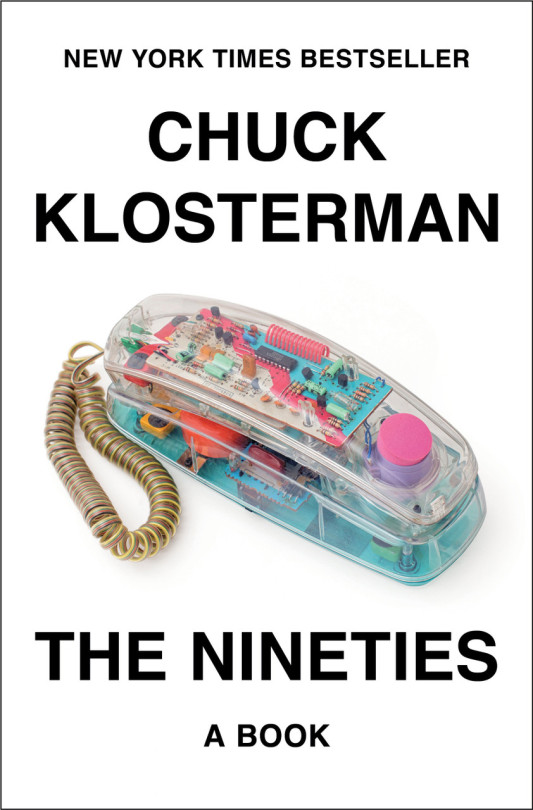
Chuck Klosterman has written a sociological history book on the 1990s that is on par with the best works of Rick Perlstein. He has created a book that leaves nothing out while using historical subtext and conceptualization to define an era best known for the impact of Generation X and dividing the world between a world without the internet – and the adaptation of the internet. He astutely writes that Group A, born before 1945, could exist without the internet, and Group C, born after 1990, vaguely remembers life before the internet. Group B, the Boomers, and Generation X have a foot in both worlds. The Nineties is academically written, no more so than the arrival of the internet in American homes in the later part of the decade. While it would be a disservice to categorize Klosterman's book as a "look – it's Monica Lewinsky" book of nostalgia, he can't help but ignite these feelings of wistfulness when he astutely writes about the procedural sound of the dial-up modem and the preponderance of AOL installation discs that were handed out like plastic coasters.
Klosterman covers the political landscape of the time, from George H.W. Bush's high approval ratings to losing the 1992 election to the 5-4 decision of the Supreme Court to declare George W. Bush the winner of the 2000 presidential race. The 90s era, as seen in politics, includes the Gulf War, Colin Powell, Bob Dole, Ken Starr, the navy dress, Rock the Vote, Al Gore, and, of course, Ross Perot. Klosterman acutely centers on the 19% of voters who voted for Perot who were dissatisfied with the two choices. He is smart enough not to come out and say it, but it is easy to take this percentage, expand on it, and have it play out in the 2016 election.
Cinema in the 1990s makes for a captivating insertion. The early 1990s were best known for starting the independent film explosion with directors like Kevin Smith, Richard Linklater, and most importantly, Quentin Tarantino. Klosterman's theory is that the abundance of video stores gave people outside the most prominent cities access to smaller movies, classics, and foreign cinema that was not readily available by flipping channels. The author also touches on the phenomenon known as Titanic and the explosion of Leo DiCaprio as a new kind of actor.
While the book (which could easily have doubled the length) is light on literature, comedy, and fashion, Klosterman points out the success of Friends and Seinfeld and the early stages of prestige television. With literature, he does reference the decade's "navel gazers," like Dave Eggers and Elizabeth Wurtzel, who wrote a new kind of idiosyncratic memoir. Musically, as expected, he covers Kurt Cobain and Tupac Shakur but also examines the female voice in the mid-90s, as represented by Alanis Morissette and Liz Phair. In addition, Klosterman interviews Douglas Coupland (one of my favorite authors) regarding his role in creating the term Generation X.There is so much to recommend in this book. His reach is as expansive as it is gratifying: OJ Simpson, Waco, Oklahoma City, ER, Netscape, Y2K, Chandra Levy, Biosphere 2, Tiger Woods, Michael Jordan, The Matrix, Clarence and Anita, Alan Greenspan, The Phantom Menace, Oprah Winfrey, Pauly Shore, Ralph Nader, Reality Bites, Boris Yeltsin, Mark Leyner, the 1994 Baseball Strike, and enough names to fill out a hundred more Billy Joel songs. Exhaustively researched, Klosterman ends the decade the only way it could end: "The flights were hijacked, the planes crashed into buildings, 2,977 people died, and the nineties collapsed with the skyscrapers."
1 note
·
View note